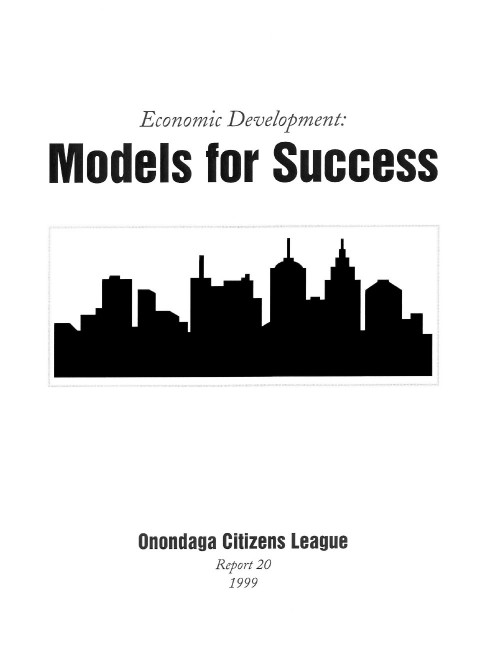Introduction
The 1999 Onondaga Citizens League study, “Economic Development: Models for Success”, looked at the activities of five communities-Saratoga, Milwaukee, Indianapolis, Silicon Valley and Baltimore-known for the success of their economic development efforts. Speakers from those cities, as well as representatives of economic development organizations in Central New York, presented a picture of the status of economic development strategies in our area, and provided possible approaches to specific aspects of community and economic development that might be applicable to our community.
Overall Findings
Important strategies that were common practices in successful communities:
- Take a regional approach.
- Value unique local strengths and build on them.
- Invest in good planning, good data, and good staff.
- Retain the current base of businesses.
- Collaborate widely on economic development efforts.
- Use a team approach to site development and site visits, and create opportunities that are “shovel ready.”
Conditions that must be met for economic development efforts to be fully successful:
- Success must include all stakeholders.
- The city, the core of our region, must flourish.
- The role of government in economic development is to create the fertile ground in which the private sector can flourish.
- The people of our region must be recognized and developed as our greatest asset.
- Exemplary leadership must flow from the civic sector in ways that connect effectively at all levels.
- We must develop community understanding to create confidence and sustainable vision.
General Recommendations
Create fertile ground for private sector growth through good government practices
- Improve the efficiency of government services through consolidation, privatization, outsourcing, employee incentives and other means to lower the cost of government, reduce taxes, improve services and create a more attractive business climate.
- Hold government and government-supported agencies accountable through measurable standards of performance.
Think and act regionally and collaboratively
- Link economic development to community development by having economic development practitioners work with community development leaders and other stakeholders so that community needs and assets and character are reflected in economic development goals and projects and vice versa.
- Businesses, working with schools and other training providers should take the lead in workforce development.
- Institutions of higher education need to take a full, collaborative role in economic development in the community.
Invest in data collection and the establishment of benchmarks that measure our progress toward community goals
- Set goals collaboratively, determine current status of goal indicators (government performance, workforce development, available jobs, etc.), and invest in systems for ongoing measurement of performance.
- Assess our status in these areas on a regular schedule and publish the results.
Back to "Successful Economic Development Models: Lessons for Central New York"

